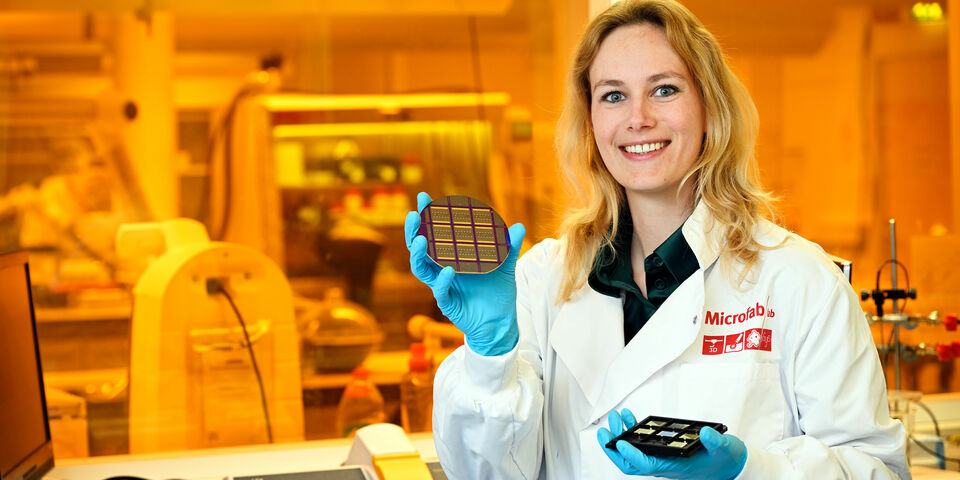Home Stretch | Smart chip in your body
Current computer systems are very good at performing exact calculations. But as we are using more and more AI-based applications, we also need more efficient systems that are able to process data in real time with the same precision. TU/e researcher Eveline van Doremaele is working on a new generation of computers, modeled after the human brain. What’s more, she used organic materials for the unique chip she developed with neuromorphic computing, which means it is able to interact with our bodies.
Self-driving cars, facial recognition, language recognition: all applications based on artificial intelligence. To make these possible, computer systems need to adapt to an increasingly dynamic environment and be able to handle unstructured and imperfect data. Current artificial neural networks work well, but also have significant disadvantages. For instance, they use a lot of energy and take a relatively long time to perform complex calculations. This is why TU/e researcher Eveline van Doremaele spent the last few years working on a new generation of computer systems, developing a smart chip that can be used for a variety of applications in the human body. On Thursday 25 May she will be defending her dissertation at the Department of Mechanical Engineering.
Mimicking the brain
“We ourselves carry around a perfect system for performing complex tasks,” Van Doremaele says while briefly touching her head, which was ‘on’ for four years. “Our brain is very good at dealing with uncertainties and works very efficiently in changing circumstances. This is mainly owing to the brain’s ability to execute processes and calculations at the same time, as well as learn based on previous experiences. That’s exactly what we need for AI applications.”
It's no wonder neuromorphic computing – mimicking the structure and function of our brain in a computer system – has been on the rise in recent years, says Van Doremaele. “Energy-efficient, fast and dynamic, our brain demonstrates how a perfect computer system should function, thereby serving as a huge source of inspiration to our group and other scientists. We take it to the next level by trying to develop a device centering on the self-learning interaction between people and machines. Examples include a smart prosthetic arm that you can hook up to your body and that you can teach to grab a pen thanks to artificial neurons, a chip that uses different sensors at the same time to detect a circulating cancer cell between millions of normal cells, and a pacemaker that can adapt to an ageing heart. Once we have the technology up and running, the applications are infinite.”
Self-learning system
To make such a chip, Van Doremaele set out in search of suitable materials that both lend themselves to programming and are well-received by our bodies. Van Doremaele’s research shows that conductive organic polymers, long molecules that allow electric current to pass through, are very effective in this respect. “To enable the system to self-learn, it’s essential for the resistance in the device to be variable. This also happens in our brain: as you learn something more often, the connection between the neural cells grows stronger. Using ions actually allows us to vary the resistance, but we also want to make the connection permanent,” she explains.
“Until now, the usage of materials in which the connections grow weaker over time has been common to our field,” the PhD candidate continues. “In the case of a prosthetic arm, this would mean that after a month you would, for example, no longer know how to pick up a pen. P-3O, the ambipolar material we tested, is unique: it is able to vary the resistance and retain the connection created. It also works both with a liquid electrolyte, such as in a watery environment within the body, and with a solid electrolyte, an ion gel. By linking cells to each other, we can make complex circuits with certain characteristics. This comes in handy when measuring weak signals, such as minute muscle movements, or signals that are surrounded by a lot of noise, such as a heartbeat.
Measuring sweat samples
Even though a lot of further research is necessary to perform complex measurements, Van Doremaele did already use neuromorphic computing to develop a biosensor that could analyze test subjects’ sweat samples for the presence of the hereditary disease cystic fibrosis. “Using different sensors, the chip can measure the potassium and chlorine content of the sweat. We had the system make predictions for every sweat sample. If the prediction was wrong, I pressed a button and the system corrected itself. In the end, the biosensor only gave correct answers. So it learned in a unique way, like a neuron in the human brain. This provides us with a basis we can elaborate on.”
Van Doremaele has noticed a lot of interest in her work. “AI is virtually everywhere and it’s only going to get more omnipresent. But the energy problem is also increasing, as data centers use enormous amounts of energy. This means it’s essential we find alternative computer systems. Our focus on organic materials for self-learning biomedical applications is pretty unique. There are only a handful of groups working on this, often in joint projects. Given the project’s multidisciplinary nature, we also established connections on campus. By looking for colleagues with different backgrounds and by sharing a lot of knowledge, I became the linking pin between the TU/e research institutes EAISI (Artificial Intelligence) and ICMS (Complex Molecular Systems). A PhD can be lonely sometimes, but I have a colossal acknowledgement in my dissertation to show for it.”


Discussion